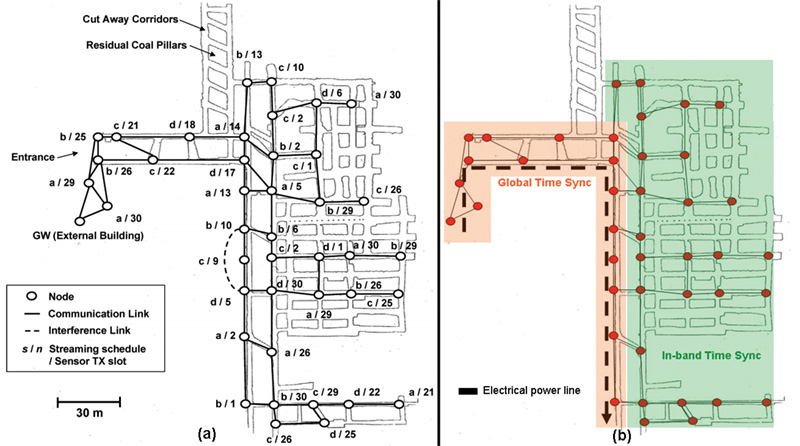|
Overview
FireFly is a low-cost wireless sensor network platform
capable of data acquisition, processing & multi-hop mesh
communication. Each battery-operated node functions with
scalable & economical global time-synchronization and
delivers a lifetime of 1.5-2 years. Fixed and mobile nodes
can dynamically form a network and facilitate applications
such as utility monitoring, surveillance, location tracking
and voice communication. It is easy to add-on custom modules
for user-specific applications.
Features
Each FireFly node features an IEEE 802.15.4 transceiver
capable of short-range (50-100m) data communication with a
maximum raw data rate of 250Kbps. An 8-bit microcontroller
processes data from (optional) on-board light, motion,
audio, temperature and acceleration sensors. Each node has a
SD Flash card slot for add-on data acquisition and storage
modules. In addition, FireFly nodes feature a low-power
AM/FM radio receiver to periodically acquire a time
synchronization pulse. The time sync pulse is radiated
through the building using an AM carrier current transmitter
(FCC part 15 compliant). The AM radio transmitter is plugged
into a power outlet in the building and uses the building’s
power grid as an extended AM antenna to radiate a periodic
pulse. For example, in our test-bed at Carnegie Mellon
University, we are able to radiate a 50us pulse once every 5
seconds across an 8-story campus building. Our 2nd
generation design features a digital Radio Data Broadcast
System (RDBS) receiver so any public radio station can
broadcast the time sync pulse across cities. FireFly runs
the Nano-RK real-time sensor operating system for easy
deployment.
How it Works
Global time synchronization enables extremely energy
efficient operation and extends the lifetime of each node by
a factor of 4-5X more than current sensor networking
platforms. Global time synchronization maximizes the common
sleep time between nodes and enables high throughput
operation with bounded end-to-end delay. Each node is
scheduled to transmit and receive data on dedicated 5ms time
slots and are shutdown at all other times. As shown in the
figure on the right, nodes operate with Low Power Listening
(small pulses) where they wake up for 25us, check if there
is any transmission and go back to sleep if there is none.
If there is data to be received, they wake up on
pre-assigned slots (long pulses) and promptly go back to
sleep after activity. Nodes also operate in contention mode
(series of short pulses) where a mobile or unscheduled node
may send data in one of many available contention slots.
This way we cater to both delay sensitive periodic sensing
and communication tasks and also to asynchronous
environment-triggered events in an energy efficient manner.
Performance
Using
this tightly time synchronized regime of operation, nodes
with pre-programmed or dynamically assigned schedules are
able to achieve the maximum possible throughput in a
collision-free manner. The table on the right lists the
low-power operation values for each FireFly node. Real-time
applications such as delay sensitive voice communication
(24ms packet intervals), image capture and forwarding for
surveillance (150kbps goodput) and asset tracking
(in-network processing) are examples where FireFly nodes
have been used.
Through experiments and analysis we have demonstrated that
the Real-Time Link (RT-Link) protocol running over a network
of FireFly nodes is capable of operating with an effective
lifetime of 1-2 years on 2AA Li-ion batteries. RT-Link
outperforms Low-Power Listen CSMA protocols such as the
Berkeley B-MAC sensor protocol by the use of hardware-based
global time synchronization.
Deployment
Experiences
We
have successfully deployed a network of 42 FireFly nodes in
the NIOSH coal mine for people tracking (bottom left
figure). The network was configured to deliver both low
duty-cycle sensor data and high rate voicemail communication
for stranded miner. At all times, the latest position of the
miners was tracked. The sensor network functions with a low
duty-cycle during normal operation and is able to switch
over to a high-rate mode for voice communication during
emergencies. RT-Link supports on-demand rate control and can
switch the networks operation based on the current
application’s throughput and end-to-end delay requirements.
A multi-hop mesh network of FireFly
nodes was deployed in a campus building to report
surveillance sensor data (bottom right figure) and detect
people presence across the floor.

FireFly supports both hardware-based
global time synchronization and in-band software-based sync.
(a) Shows the TDMA schedule generated to support both
high-speed voice streaming and low-speed sensor probing. (b)
Shows the hybrid time sync with hardware sync along the mine
backbone and software sync everywhere else.
|